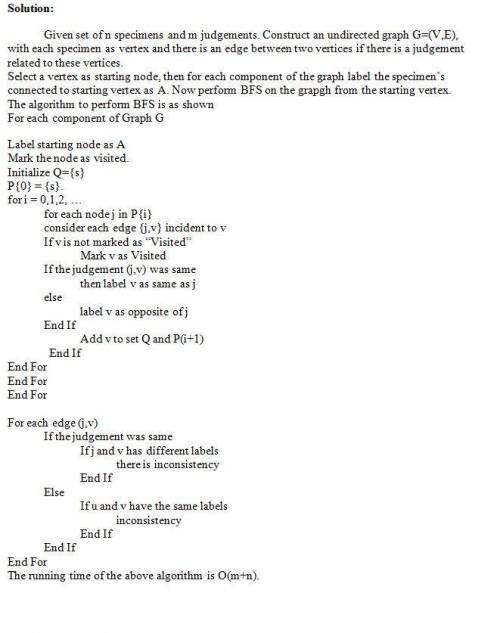
Engineering, 07.03.2020 03:32 surfer89
Inspired by the example of that great Cornellian, VladimirNabokov, some of your friends have become amateur lepidopterists (they study butter- flies). Often when they return from a trip with specimens of butterflies, it is very difficult for them to tell how many distinct species they’ve caught—thanks to the fact that many species look very similar to one another.
One day they return with n butterflies, and they believe that each belongs to one of two different species, which we’ll call A and B for purposes of this discussion. They’d like to divide the n specimens into two groups—those that belong to A and those that belong to B—but it’s very hard for them to directly label any one specimen. So they decide to adopt the following approach.
For each pair of specimens i and j, they study them carefully side by side. If they’re confident enough in their judgment, then they label the pair (i, j) either "same" (meaning they believe them both to come from the same species) or "different" (meaning they believe them to come from different species). They also have the option of rendering no judgment on a given pair, in which case we’ll call the pair ambiguous.
So now they have the collection of n specimens, as well as a collection of m judgments (either "same" or "different") for the pairs that were not declared to be ambiguous. They’d like to know if this data is consistent with the idea that each butterfly is from one of species A or B. So more concretely, we’ll declare the m judgments to be consistent if it is possible to label each specimen either A or B in such a way that for each pair (i, j) labeled "same," it is the case that i and j have the same label; and for each pair (i, j) labeled "different," it is the case that i and j have different labels. They’re in the middle of tediously working out whether their judgments are consistent, when one of them realizes that you probably have an algorithm that would answer this question right away.
Give an algorithm with running time O(m + n) that determines whether the m judgments are consistent.

Answers: 1


Another question on Engineering

Engineering, 04.07.2019 18:10
For the closed feedwater heater below, feedwater enters state 3 at a pressure of 2000 psia and temperature of 420 °f at a rate of ix10 ibhr. the feedwat extracted steam enters state 1 at a pressure of 1000 psia and enthalpy of 1500 btu/lbm. the extracted er leaves at an enthalpy of 528.7 btu/lbm steam leaves as a saturated liquid. (16) a) determine the mass flow rate of the extraction steam used to heat the feedwater (10) b) determine the terminal temperature difference of the closed feedwater heater
Answers: 3

Engineering, 04.07.2019 18:10
You are making beer. the first step is filling the glass carboy with the liquid wort. the internal diameter of the carboy is 15 in., and you wish to fill it up to a depth of 2 ft. if your wort is drawn from the kettle using a siphon process that flows at 3 gpm, how long will it take to fill?
Answers: 1

Engineering, 04.07.2019 18:10
A-mn has a cubic structure with a0 0.8931 nm and a density of 7.47 g/cm3. b-mn has a different cubic structure, with a0 0.6326 nm and a density of 7.26 g/cm3. the atomic weight of manganese is 54.938 g/mol and the atomic radius is 0.112 nm. determine the percent volume change that would occur if a-mn transforms to b-mn.
Answers: 2

Engineering, 04.07.2019 18:10
Hydraulic fluid with a sg. of 0.78 is flowing through a 1.5 in. i.d. pipe at 58 gal/min. the fluid has an absolute viscosity of 11.8 x 105 lbf-sec/ft2. is the flow laminar, turbulent or within the critical range? give both a numerical reynolds number and a term answer.
Answers: 3
You know the right answer?
Inspired by the example of that great Cornellian, VladimirNabokov, some of your friends have become...
Questions



Mathematics, 09.01.2020 14:31




Mathematics, 09.01.2020 14:31

History, 09.01.2020 14:31

Mathematics, 09.01.2020 14:31


Mathematics, 09.01.2020 14:31

Mathematics, 09.01.2020 14:31




Mathematics, 09.01.2020 14:31


Computers and Technology, 09.01.2020 14:31

Spanish, 09.01.2020 14:31




